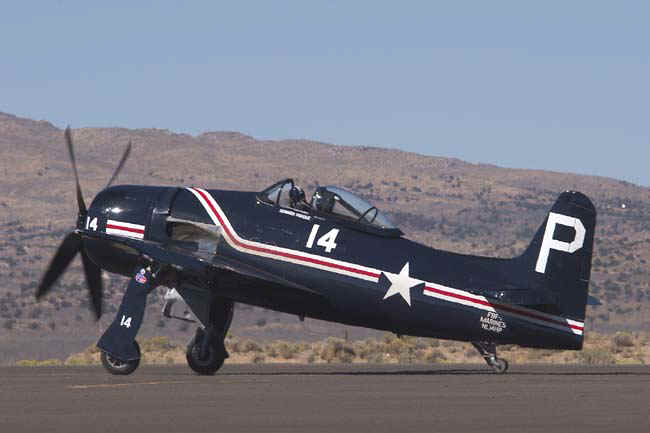|

Grumman F8F Bearcat owned and flown by Howard Pardue
at Reno, Nevada, USA, September 2003.
Photo by C.F. Smith
History: The Bearcat was the last of
Grumman's piston-engine carrier-based fighters. Two XF8F-1
prototypes were ordered in November 1943, and the first of these was flown on 21 August
1944. Grumman decided once again to utilize the most powerful engine available at the
time, the Pratt & Whitney R-2800 Double Wasp -- the same engine that had powered both
their Hellcat and Tigercat designs. This time, the engine was fitted to the smallest,
lightest airframe that could be built. This resulted in a highly maneuverable, fast
airplane with a rate of climb 30% greater than the Hellcat.
Production of the F8F-1 began just
six months after the first flight of the prototype, and the first airplane was delivered
to the US Navy's VF-19 squadron on 21 May 1945. The Navy's order totaled 2,033 airplanes,
and Grumman contracted with General Motors to build the Bearcat under license, with the
designation F8FM-1. Only a few Bearcats had been delivered to
the Navy when the end of the war halted production. Grumman cancelled 1,258 of its
Bearcats, and General Motors cancelled its entire order of 1,876. Production resumed after
the war, and several variants were produced, including the F8F-1B,
with four 20mm cannon in place of the previously-fitted 12.7mm (0.5 inch) machine guns;
several night fighter variants (F8F-1N and F8F-2N);
and a photo-reconnaissance version (F8F-2P). Production
continued until May 1949.
At least 24 US Navy squadrons flew the Bearcat, some until as
late as 1952, after which some were sold to the French Armee de l'Air for combat
operations in Indo-China. Another 129 Bearcats were sold to the Thai Air Force.
Nicknames: Beercat (Armee de l'Air)
Specifications (F8F-1B):
Engine: 2,100hp Pratt & Whitney R-2800-34W Double Wasp
18-cylinder radial piston engine
Weight: Empty 7,070 lbs., Max Takeoff 12,947 lbs.
Wing Span: 35ft. 10in.
Length: 28ft. 3in.
Height: 13ft. 10in.
Performance:
Maximum Speed at 19,700ft: 421mph
Cruising Speed: 163mph
Initial Climb Rate: 4,570 feet per minute
Ceiling: 38,700ft
Range: 1,105 miles
Armament:
Four 20mm cannon
Hard points for two 1,000lb bombs, or
four 127mm (5-inch) rockets, or two 150-gal fuel tanks
Number Built: 1,266
Number Still Airworthy: ~10
 [
Bearcat Pilot Report by
John Deakin ]
[
Bearcat Pilot Report by
John Deakin ]
Links:
Bearcat BuNo. 121776 -- Restoration
project at Milton, Florida, USA. (Also see First Flight report.)
NASA
F8F Bearcat Technical Evaluation -- (Highly technical)
Rare Bear Air Race Team
F8F Bearcat books from Amazon.com:

[Back to Warbird Alley's Main
Page]
All text and photos Copyright 2016 The Doublestar Group, unless otherwise noted.
You may use this page for your own, non-commercial reference purposes only.

|